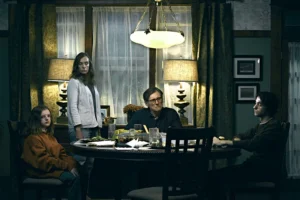You can close your eyes during a horror movie, but you can’t close your ears. Long before a monster appears or a door creaks open, the music tells you something is wrong. A quiet hum turns uneasy, a familiar melody detunes, and suddenly the most ordinary scene—a hallway, a child’s toy, a mirror—feels like a threat.
Music is one of the most powerful tools in horror because it taps directly into emotion. It doesn’t just accompany fear—it creates it. Even without visuals, the right sound can make your pulse quicken and your stomach drop. But how does it work?

Ari Aster’s 2018 psychological horror film Hereditary uses sound as its most haunting weapon. The film’s chilling original score—composed by JUNO Award winner Colin Stetson—turns breath, wood, and vibration into pure dread, proving that in horror, the scariest moments are often the ones you hear, not see.
At the heart of horror scores is tension without release. Spooky music thrives on dissonance—notes that clash or vibrate uncomfortably against each other. Think of the piercing strings from Psycho or the grinding cello from Jaws. These sounds never quite resolve into something harmonious, leaving your brain suspended in anxiety.
Composers often withhold resolution entirely. Instead of landing on the “home” chord that gives a listener relief, horror scores linger in limbo. The result? Your body stays on alert, waiting for something that may never come.
Minor keys are naturally darker than major ones. They lower certain notes, creating a sound our brains associate with sadness, danger, or mystery. Horror often builds on this foundation using scales that sound unnatural—like diminished or whole-tone scales, which float without a clear tonal centre. These tonal ambiguities trick your ear into expecting danger. The melody itself becomes the villain.
Horror music isn’t always about noise. Silence—or near silence—can be just as frightening. Composers use sudden pauses or unpredictable rhythms to create space for your imagination to fill in the blanks. A single heartbeat-like drum or a slowly ticking clock can stretch tension to the breaking point.
When the sound finally returns, it often does so violently: a crash, a shriek, or a distorted swell that feels almost physical. That contrast between stillness and chaos is what makes audiences jump out of their seats.
Certain sounds immediately signal “danger.” The human ear reacts strongly to high-pitched frequencies, scraping, or whispers—all sounds that mimic distress calls in nature. That’s why trembling violins, distorted guitars, and detuned pianos feel instinctively wrong. Horror composers also love the uncanny: the familiar made strange. A music box or lullaby—symbols of comfort—become chilling when slowed down or played off-key.
Few modern composers capture these ideas as vividly as JUNO-winner Colin Stetson, whose score for Hereditary is a masterclass in psychological horror. Throughout the film, Stetson builds dense, unresolved harmonic tension with dissonant clusters of minor seconds and tritones. In “Reborn,” layers of unsettling tones never resolve, keeping the listener emotionally suspended—a sonic mirror to the family’s growing dread.
Stetson skillfully manipulates silence and rhythm to heighten tension. In “Funeral,” careful pacing allows silence and droning to stretch moments of extreme anxiety, with sudden bursts of sound shocking the listener. The rhythm of heartbeat-like pulses and unpredictable attacks in tracks like “Party, Crash” gives space for the imagination to conjure fear, making the eventual sonic onslaughts feel all the more jarring.
His choice of instrumentation seals the effect. What sounds like strings is often something else entirely. Stetson layers clarinet and voice together, manipulating them beyond recognition until they feel like a living, breathing entity. What might register as a synthesizer is, in fact, contrabass and bass clarinet—de-pitched, blended, and magnified in post-production to create what he calls “a deep, creaking, woody quality.” Even the percussion isn’t percussion at all: it’s the physical sound of the woodwind keys themselves, miked so closely and so loudly that they boom like drums.
Colin Stetson’s Hereditary score is a chilling reminder of music’s psychological power—how dissonance, silence, and sound design can turn the ordinary into the unthinkable. In horror, after all, the scariest thing isn’t what you see—it’s what you hear.